Financial Analysis of TSB Bank: Performance and Sector Impacts
VerifiedAdded on 2023/01/12
|10
|3282
|76
Report
AI Summary
This report provides a comprehensive analysis of TSB Bank's financial performance. It begins with an introduction to modern banking systems, focusing on TSB Bank as a case study. The main body includes an overview of TSB Bank's business activities, followed by a critical analysis of changes in its assets, liabilities, and income structure from 2018 to 2019. The report evaluates the bank's performance using ratio analysis, including operating margin, net profit margin, efficiency ratio, and return on assets, and interprets the trends. Furthermore, it assesses the impact of banking sector changes, such as digital transformation, Brexit, and the rise of FinTech, on TSB Bank's performance. The analysis also considers the effects of consolidation within the UK banking sector. The report concludes with an assessment of TSB Bank's expected future performance, considering the challenges and opportunities presented by the evolving banking landscape. The report highlights the need for TSB Bank to improve its liquidity and profitability.
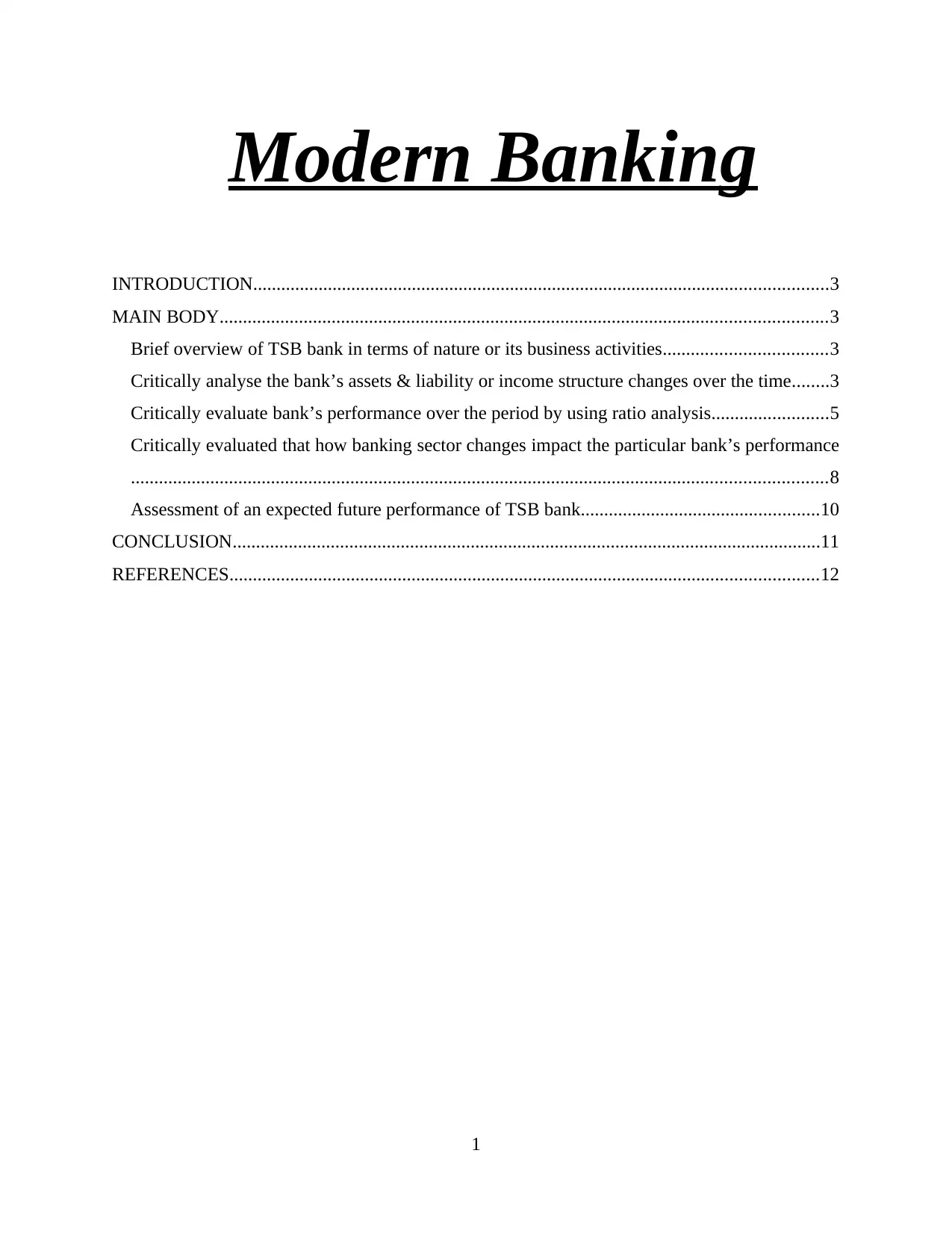
Modern Banking
INTRODUCTION...........................................................................................................................3
MAIN BODY..................................................................................................................................3
Brief overview of TSB bank in terms of nature or its business activities...................................3
Critically analyse the bank’s assets & liability or income structure changes over the time........3
Critically evaluate bank’s performance over the period by using ratio analysis.........................5
Critically evaluated that how banking sector changes impact the particular bank’s performance
.....................................................................................................................................................8
Assessment of an expected future performance of TSB bank...................................................10
CONCLUSION..............................................................................................................................11
REFERENCES..............................................................................................................................12
1
INTRODUCTION...........................................................................................................................3
MAIN BODY..................................................................................................................................3
Brief overview of TSB bank in terms of nature or its business activities...................................3
Critically analyse the bank’s assets & liability or income structure changes over the time........3
Critically evaluate bank’s performance over the period by using ratio analysis.........................5
Critically evaluated that how banking sector changes impact the particular bank’s performance
.....................................................................................................................................................8
Assessment of an expected future performance of TSB bank...................................................10
CONCLUSION..............................................................................................................................11
REFERENCES..............................................................................................................................12
1
Paraphrase This Document
Need a fresh take? Get an instant paraphrase of this document with our AI Paraphraser
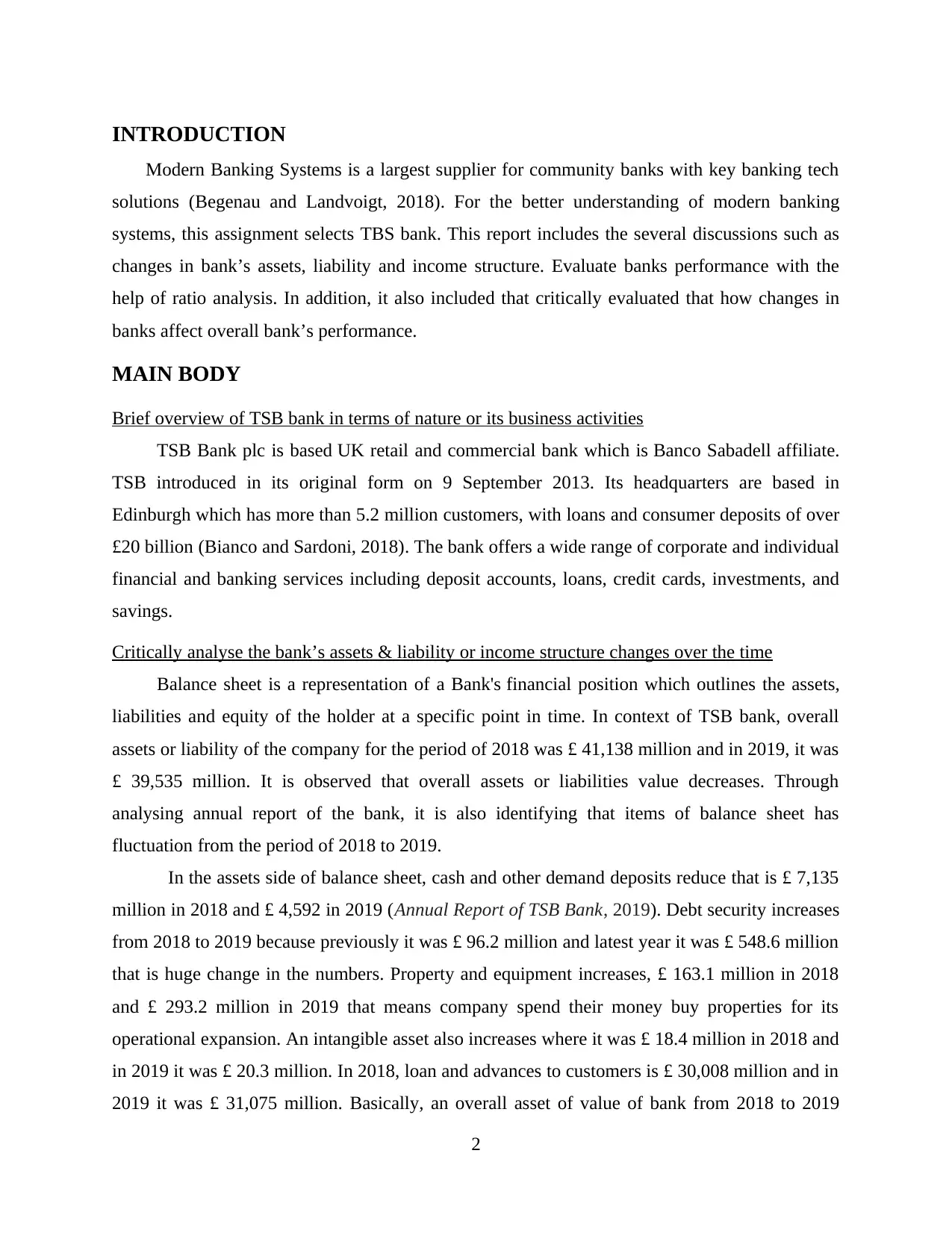
INTRODUCTION
Modern Banking Systems is a largest supplier for community banks with key banking tech
solutions (Begenau and Landvoigt, 2018). For the better understanding of modern banking
systems, this assignment selects TBS bank. This report includes the several discussions such as
changes in bank’s assets, liability and income structure. Evaluate banks performance with the
help of ratio analysis. In addition, it also included that critically evaluated that how changes in
banks affect overall bank’s performance.
MAIN BODY
Brief overview of TSB bank in terms of nature or its business activities
TSB Bank plc is based UK retail and commercial bank which is Banco Sabadell affiliate.
TSB introduced in its original form on 9 September 2013. Its headquarters are based in
Edinburgh which has more than 5.2 million customers, with loans and consumer deposits of over
£20 billion (Bianco and Sardoni, 2018). The bank offers a wide range of corporate and individual
financial and banking services including deposit accounts, loans, credit cards, investments, and
savings.
Critically analyse the bank’s assets & liability or income structure changes over the time
Balance sheet is a representation of a Bank's financial position which outlines the assets,
liabilities and equity of the holder at a specific point in time. In context of TSB bank, overall
assets or liability of the company for the period of 2018 was £ 41,138 million and in 2019, it was
£ 39,535 million. It is observed that overall assets or liabilities value decreases. Through
analysing annual report of the bank, it is also identifying that items of balance sheet has
fluctuation from the period of 2018 to 2019.
In the assets side of balance sheet, cash and other demand deposits reduce that is £ 7,135
million in 2018 and £ 4,592 in 2019 (Annual Report of TSB Bank, 2019). Debt security increases
from 2018 to 2019 because previously it was £ 96.2 million and latest year it was £ 548.6 million
that is huge change in the numbers. Property and equipment increases, £ 163.1 million in 2018
and £ 293.2 million in 2019 that means company spend their money buy properties for its
operational expansion. An intangible asset also increases where it was £ 18.4 million in 2018 and
in 2019 it was £ 20.3 million. In 2018, loan and advances to customers is £ 30,008 million and in
2019 it was £ 31,075 million. Basically, an overall asset of value of bank from 2018 to 2019
2
Modern Banking Systems is a largest supplier for community banks with key banking tech
solutions (Begenau and Landvoigt, 2018). For the better understanding of modern banking
systems, this assignment selects TBS bank. This report includes the several discussions such as
changes in bank’s assets, liability and income structure. Evaluate banks performance with the
help of ratio analysis. In addition, it also included that critically evaluated that how changes in
banks affect overall bank’s performance.
MAIN BODY
Brief overview of TSB bank in terms of nature or its business activities
TSB Bank plc is based UK retail and commercial bank which is Banco Sabadell affiliate.
TSB introduced in its original form on 9 September 2013. Its headquarters are based in
Edinburgh which has more than 5.2 million customers, with loans and consumer deposits of over
£20 billion (Bianco and Sardoni, 2018). The bank offers a wide range of corporate and individual
financial and banking services including deposit accounts, loans, credit cards, investments, and
savings.
Critically analyse the bank’s assets & liability or income structure changes over the time
Balance sheet is a representation of a Bank's financial position which outlines the assets,
liabilities and equity of the holder at a specific point in time. In context of TSB bank, overall
assets or liability of the company for the period of 2018 was £ 41,138 million and in 2019, it was
£ 39,535 million. It is observed that overall assets or liabilities value decreases. Through
analysing annual report of the bank, it is also identifying that items of balance sheet has
fluctuation from the period of 2018 to 2019.
In the assets side of balance sheet, cash and other demand deposits reduce that is £ 7,135
million in 2018 and £ 4,592 in 2019 (Annual Report of TSB Bank, 2019). Debt security increases
from 2018 to 2019 because previously it was £ 96.2 million and latest year it was £ 548.6 million
that is huge change in the numbers. Property and equipment increases, £ 163.1 million in 2018
and £ 293.2 million in 2019 that means company spend their money buy properties for its
operational expansion. An intangible asset also increases where it was £ 18.4 million in 2018 and
in 2019 it was £ 20.3 million. In 2018, loan and advances to customers is £ 30,008 million and in
2019 it was £ 31,075 million. Basically, an overall asset of value of bank from 2018 to 2019
2

decreases and it has several reasons. Further discussion is all about the changes in liabilities side
from the period of 2018 to 2019.
In the liability side of balance sheet, borrowings from central banks reduce from £ 6,482
million to £ 4,483 million for the period of 2018 to 2019. Customer deposits increase from 2018
to 2019 where the value was £ 29,094 million to £ 30,182 million. In 2018, debt securities in
issues were £ 1,122 million and £ 1,676 million in 2019. Portfolio hedged risk heavily increases
such as in 2018 it was £ 9.4 million and on 2019 it was £ 52.2 million (Carruthers, 2018)
(Danyali, 2018).
According to income statement of TSB bank for the period of 2018 to 2019, it was
critically evaluated that interest income from 2018 to 2019 duration decreases with £ 22 million.
So, net interest income for the period of 2018 was £ 884.8 million and in 2019 it was £ 841.1
which shows the decline around £ 43.7 million. At the end, comprehensive income for the
duration of 2018 was £ (60.1) million which was a loss and in 2019 bank generate profit of £
21.9 million.
From the analysis of balance sheet and income statement performance, it has been
analysed that TSB bank’s performance in terms of liquidity was reduces that is not beneficial for
organization, company should improve their liquidity through generating more cash and
noncurrent assets. On the other side, performance of TSB bank in term of profitability also
reduces which affect the overall operational efficiency and affect the bank to fulfil their working
capital requirement.
Critically evaluate bank’s performance over the period by using ratio analysis
Operating margin ratio:
Formula:
Operating margin = Operating profit / Net revenue * 100
Ratio 2014 (£ ‘
Million)
2015 (£ ‘
Million)
2016 (£ ‘
Million)
2017 (£ ‘
Million)
2018 (£ ‘
Million)
2019 (£ ‘
Million)
Net
revenue 900.2 890.7 1000.4 1096.1 1295 987
Operating
Profit 267.8 149.9 269.6 236.90 -27.7 105.9
Operating 29.75% 16.83% 26.95% 21.61% -2.13% 10.72%
3
from the period of 2018 to 2019.
In the liability side of balance sheet, borrowings from central banks reduce from £ 6,482
million to £ 4,483 million for the period of 2018 to 2019. Customer deposits increase from 2018
to 2019 where the value was £ 29,094 million to £ 30,182 million. In 2018, debt securities in
issues were £ 1,122 million and £ 1,676 million in 2019. Portfolio hedged risk heavily increases
such as in 2018 it was £ 9.4 million and on 2019 it was £ 52.2 million (Carruthers, 2018)
(Danyali, 2018).
According to income statement of TSB bank for the period of 2018 to 2019, it was
critically evaluated that interest income from 2018 to 2019 duration decreases with £ 22 million.
So, net interest income for the period of 2018 was £ 884.8 million and in 2019 it was £ 841.1
which shows the decline around £ 43.7 million. At the end, comprehensive income for the
duration of 2018 was £ (60.1) million which was a loss and in 2019 bank generate profit of £
21.9 million.
From the analysis of balance sheet and income statement performance, it has been
analysed that TSB bank’s performance in terms of liquidity was reduces that is not beneficial for
organization, company should improve their liquidity through generating more cash and
noncurrent assets. On the other side, performance of TSB bank in term of profitability also
reduces which affect the overall operational efficiency and affect the bank to fulfil their working
capital requirement.
Critically evaluate bank’s performance over the period by using ratio analysis
Operating margin ratio:
Formula:
Operating margin = Operating profit / Net revenue * 100
Ratio 2014 (£ ‘
Million)
2015 (£ ‘
Million)
2016 (£ ‘
Million)
2017 (£ ‘
Million)
2018 (£ ‘
Million)
2019 (£ ‘
Million)
Net
revenue 900.2 890.7 1000.4 1096.1 1295 987
Operating
Profit 267.8 149.9 269.6 236.90 -27.7 105.9
Operating 29.75% 16.83% 26.95% 21.61% -2.13% 10.72%
3
⊘ This is a preview!⊘
Do you want full access?
Subscribe today to unlock all pages.

Trusted by 1+ million students worldwide

Margin
Interpretation: From the above calculation ratio, it is observed that profit margin of the
bank increases which is beneficial for the organization and it maximise the profitability for its
users. Operating margin ratio of 2018 was -2.13 % and 2019 was 10.72%, it shows the growth of
TSB bank. It is observed that, operating margin in the 2014 was very high that was 29.75%
which decreases in 2015 and further it was again increases in 2016 at 26.95%. In 2017 it was
gain reduces and back faces the loss due to poor performance.
Net profit margin ratio:
Formula:
Net profit margin = Net profit / Net revenue *100
Ratio 2014 (£ ‘
Million)
2015 (£ ‘
Million)
2016 (£ ‘
Million)
2017 (£ ‘
Million)
2018 (£ ‘
Million)
2019 (£ ‘
Million)
Net
revenue 900.2 890.7 1000.4 1096.1 1295 987
Net profit 134.5 88.8 128.1 115.1 -59.1 26.2
Net
margin 14.94% 9.97% 12.80% 10.50% -4.56% 2.65%
Interpretation: Above calculation shows that net margin of 2018 was negative that is -
4.56% and it will increases in 2019 and provide 2.65% net margin. Net margin of TSB bank is
not constant they face huge fluctuation due to ineffective performance of the organization.
Efficiency ratio:
Formula:
Efficiency ratio = Expenses /Revenue
Ratio 2014 (£ ‘
Million)
2015 (£ ‘
Million)
2016 (£ ‘
Million)
2017 (£ ‘
Million)
2018 (£ ‘
Million)
2019 (£ ‘
Million)
Revenue 900.2 890.7 1000.4 1096.1 1295 987
Expenses 696.1 740.8 730.8 859.2 905.7 881.3
Efficiency
ratio 0.77 0.83 0.73 0.78 0.69 0.89
4
Interpretation: From the above calculation ratio, it is observed that profit margin of the
bank increases which is beneficial for the organization and it maximise the profitability for its
users. Operating margin ratio of 2018 was -2.13 % and 2019 was 10.72%, it shows the growth of
TSB bank. It is observed that, operating margin in the 2014 was very high that was 29.75%
which decreases in 2015 and further it was again increases in 2016 at 26.95%. In 2017 it was
gain reduces and back faces the loss due to poor performance.
Net profit margin ratio:
Formula:
Net profit margin = Net profit / Net revenue *100
Ratio 2014 (£ ‘
Million)
2015 (£ ‘
Million)
2016 (£ ‘
Million)
2017 (£ ‘
Million)
2018 (£ ‘
Million)
2019 (£ ‘
Million)
Net
revenue 900.2 890.7 1000.4 1096.1 1295 987
Net profit 134.5 88.8 128.1 115.1 -59.1 26.2
Net
margin 14.94% 9.97% 12.80% 10.50% -4.56% 2.65%
Interpretation: Above calculation shows that net margin of 2018 was negative that is -
4.56% and it will increases in 2019 and provide 2.65% net margin. Net margin of TSB bank is
not constant they face huge fluctuation due to ineffective performance of the organization.
Efficiency ratio:
Formula:
Efficiency ratio = Expenses /Revenue
Ratio 2014 (£ ‘
Million)
2015 (£ ‘
Million)
2016 (£ ‘
Million)
2017 (£ ‘
Million)
2018 (£ ‘
Million)
2019 (£ ‘
Million)
Revenue 900.2 890.7 1000.4 1096.1 1295 987
Expenses 696.1 740.8 730.8 859.2 905.7 881.3
Efficiency
ratio 0.77 0.83 0.73 0.78 0.69 0.89
4
Paraphrase This Document
Need a fresh take? Get an instant paraphrase of this document with our AI Paraphraser
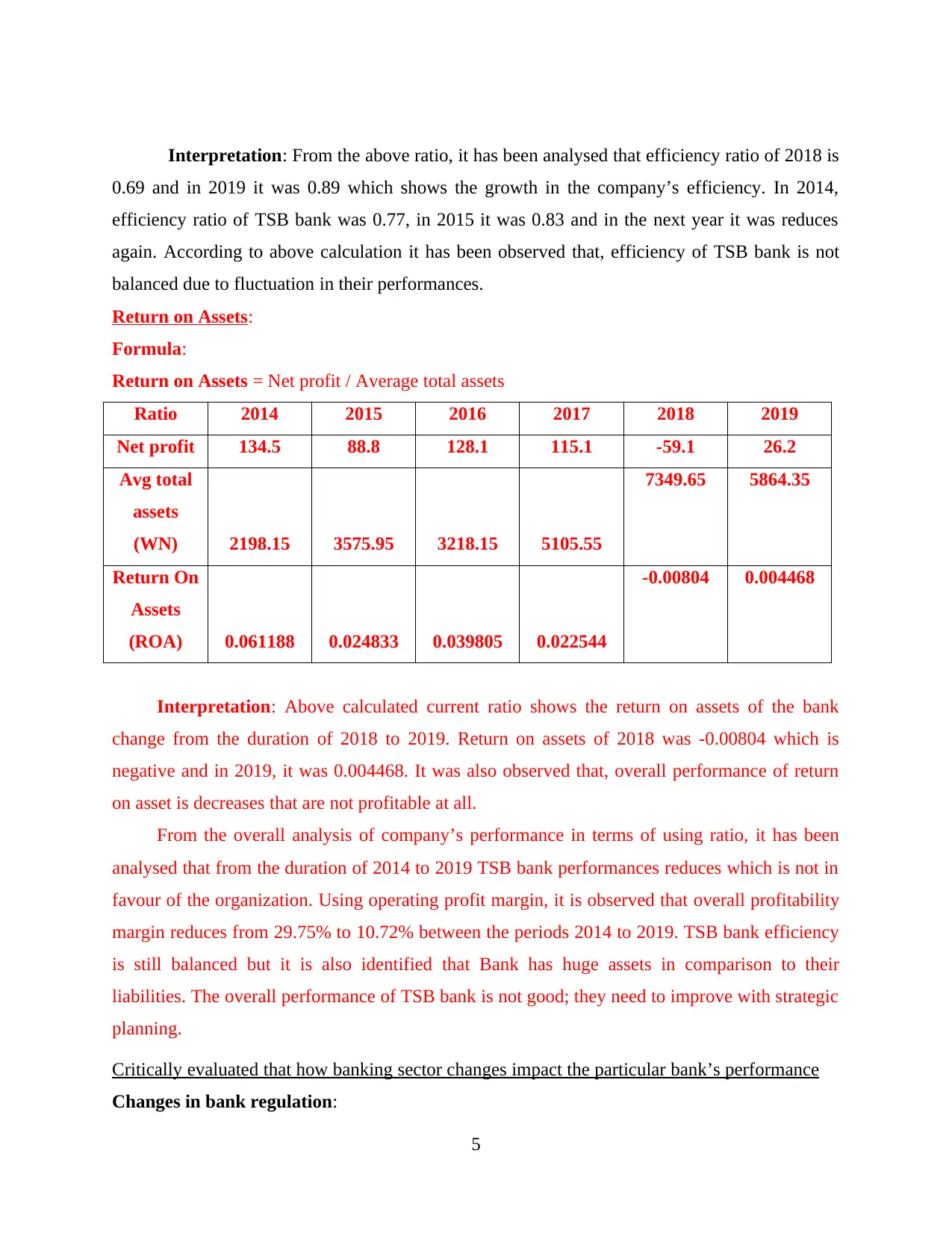
Interpretation: From the above ratio, it has been analysed that efficiency ratio of 2018 is
0.69 and in 2019 it was 0.89 which shows the growth in the company’s efficiency. In 2014,
efficiency ratio of TSB bank was 0.77, in 2015 it was 0.83 and in the next year it was reduces
again. According to above calculation it has been observed that, efficiency of TSB bank is not
balanced due to fluctuation in their performances.
Return on Assets:
Formula:
Return on Assets = Net profit / Average total assets
Ratio 2014 2015 2016 2017 2018 2019
Net profit 134.5 88.8 128.1 115.1 -59.1 26.2
Avg total
assets
(WN) 2198.15 3575.95 3218.15 5105.55
7349.65 5864.35
Return On
Assets
(ROA) 0.061188 0.024833 0.039805 0.022544
-0.00804 0.004468
Interpretation: Above calculated current ratio shows the return on assets of the bank
change from the duration of 2018 to 2019. Return on assets of 2018 was -0.00804 which is
negative and in 2019, it was 0.004468. It was also observed that, overall performance of return
on asset is decreases that are not profitable at all.
From the overall analysis of company’s performance in terms of using ratio, it has been
analysed that from the duration of 2014 to 2019 TSB bank performances reduces which is not in
favour of the organization. Using operating profit margin, it is observed that overall profitability
margin reduces from 29.75% to 10.72% between the periods 2014 to 2019. TSB bank efficiency
is still balanced but it is also identified that Bank has huge assets in comparison to their
liabilities. The overall performance of TSB bank is not good; they need to improve with strategic
planning.
Critically evaluated that how banking sector changes impact the particular bank’s performance
Changes in bank regulation:
5
0.69 and in 2019 it was 0.89 which shows the growth in the company’s efficiency. In 2014,
efficiency ratio of TSB bank was 0.77, in 2015 it was 0.83 and in the next year it was reduces
again. According to above calculation it has been observed that, efficiency of TSB bank is not
balanced due to fluctuation in their performances.
Return on Assets:
Formula:
Return on Assets = Net profit / Average total assets
Ratio 2014 2015 2016 2017 2018 2019
Net profit 134.5 88.8 128.1 115.1 -59.1 26.2
Avg total
assets
(WN) 2198.15 3575.95 3218.15 5105.55
7349.65 5864.35
Return On
Assets
(ROA) 0.061188 0.024833 0.039805 0.022544
-0.00804 0.004468
Interpretation: Above calculated current ratio shows the return on assets of the bank
change from the duration of 2018 to 2019. Return on assets of 2018 was -0.00804 which is
negative and in 2019, it was 0.004468. It was also observed that, overall performance of return
on asset is decreases that are not profitable at all.
From the overall analysis of company’s performance in terms of using ratio, it has been
analysed that from the duration of 2014 to 2019 TSB bank performances reduces which is not in
favour of the organization. Using operating profit margin, it is observed that overall profitability
margin reduces from 29.75% to 10.72% between the periods 2014 to 2019. TSB bank efficiency
is still balanced but it is also identified that Bank has huge assets in comparison to their
liabilities. The overall performance of TSB bank is not good; they need to improve with strategic
planning.
Critically evaluated that how banking sector changes impact the particular bank’s performance
Changes in bank regulation:
5

Financial regulation regarding securities requires a limit on banks' capital, accumulation
(shareholder right and citizenship) and entrances and exits from the banking system. This
restriction contains the requirement to keep government security such as 27 percent of T-bill loan
in Ethiopia, credit lending to preferred institution, manufacturing sector in the case of
Ethiopia and control of the total Credit extended and reserve requirement Monetary regulation
was found to have a major adverse impact on the performance of the banks.
There are several changes in banking regulations which affect the performance of banks
such as digital transformation, Brexit, etc. Change in digital technology is a key force of change
for the banking sector (Majid, 2020). There is a need to contend with FinTech rivals, although
rising costs and satisfying growing consumer needs means that there are no indicators of slowing
down in the continuing push to digital platforms and technology in banking. Brexit is UK
banking industry's most important focus field. Bishopsgate Financial CEO Mike Hampson
clarified that Brexit is the main area of transition expected in the year.
Increase impact of FinTech developments on banking business:
Fintech rivals are disrupting the conventional banking market, given the fact that
institutions adapt to the digital world. Banks have historically concentrated on goods, although
there are more than 55 new entrants. Fintech rivals put competition to bear on banks'
conventional business model. Fintech outlets benefit from the circumstance but depend on
government assurances that are both explicit and implied.
Fintech can be interpreted as using advanced information and mechanized farming in
financial services. New digital technology automates a diverse range of business activities and
can offer fresh and more price-effective solutions in parts of the financial sector. From lending to
wealth management and from investment, it was advised for payment system (Pilnik, Radionov
and Yazykov, 2018). Furthermore, in comparison with the scale of financial intermediated assets
and markets, the fintech field is low and lagging behind in Europe, both in terms of level and
development rate, relative to the US or China.
Consolidation in the banking sector of the particular country:
Small and medium-sized banks throughout the UK are preparing themselves for a
massive wave of consolidation as price increases, competitive pressures and a shrinking
economy are generating new obstacles for groups seeking to take on big five lenders. After
6
(shareholder right and citizenship) and entrances and exits from the banking system. This
restriction contains the requirement to keep government security such as 27 percent of T-bill loan
in Ethiopia, credit lending to preferred institution, manufacturing sector in the case of
Ethiopia and control of the total Credit extended and reserve requirement Monetary regulation
was found to have a major adverse impact on the performance of the banks.
There are several changes in banking regulations which affect the performance of banks
such as digital transformation, Brexit, etc. Change in digital technology is a key force of change
for the banking sector (Majid, 2020). There is a need to contend with FinTech rivals, although
rising costs and satisfying growing consumer needs means that there are no indicators of slowing
down in the continuing push to digital platforms and technology in banking. Brexit is UK
banking industry's most important focus field. Bishopsgate Financial CEO Mike Hampson
clarified that Brexit is the main area of transition expected in the year.
Increase impact of FinTech developments on banking business:
Fintech rivals are disrupting the conventional banking market, given the fact that
institutions adapt to the digital world. Banks have historically concentrated on goods, although
there are more than 55 new entrants. Fintech rivals put competition to bear on banks'
conventional business model. Fintech outlets benefit from the circumstance but depend on
government assurances that are both explicit and implied.
Fintech can be interpreted as using advanced information and mechanized farming in
financial services. New digital technology automates a diverse range of business activities and
can offer fresh and more price-effective solutions in parts of the financial sector. From lending to
wealth management and from investment, it was advised for payment system (Pilnik, Radionov
and Yazykov, 2018). Furthermore, in comparison with the scale of financial intermediated assets
and markets, the fintech field is low and lagging behind in Europe, both in terms of level and
development rate, relative to the US or China.
Consolidation in the banking sector of the particular country:
Small and medium-sized banks throughout the UK are preparing themselves for a
massive wave of consolidation as price increases, competitive pressures and a shrinking
economy are generating new obstacles for groups seeking to take on big five lenders. After
6
⊘ This is a preview!⊘
Do you want full access?
Subscribe today to unlock all pages.

Trusted by 1+ million students worldwide
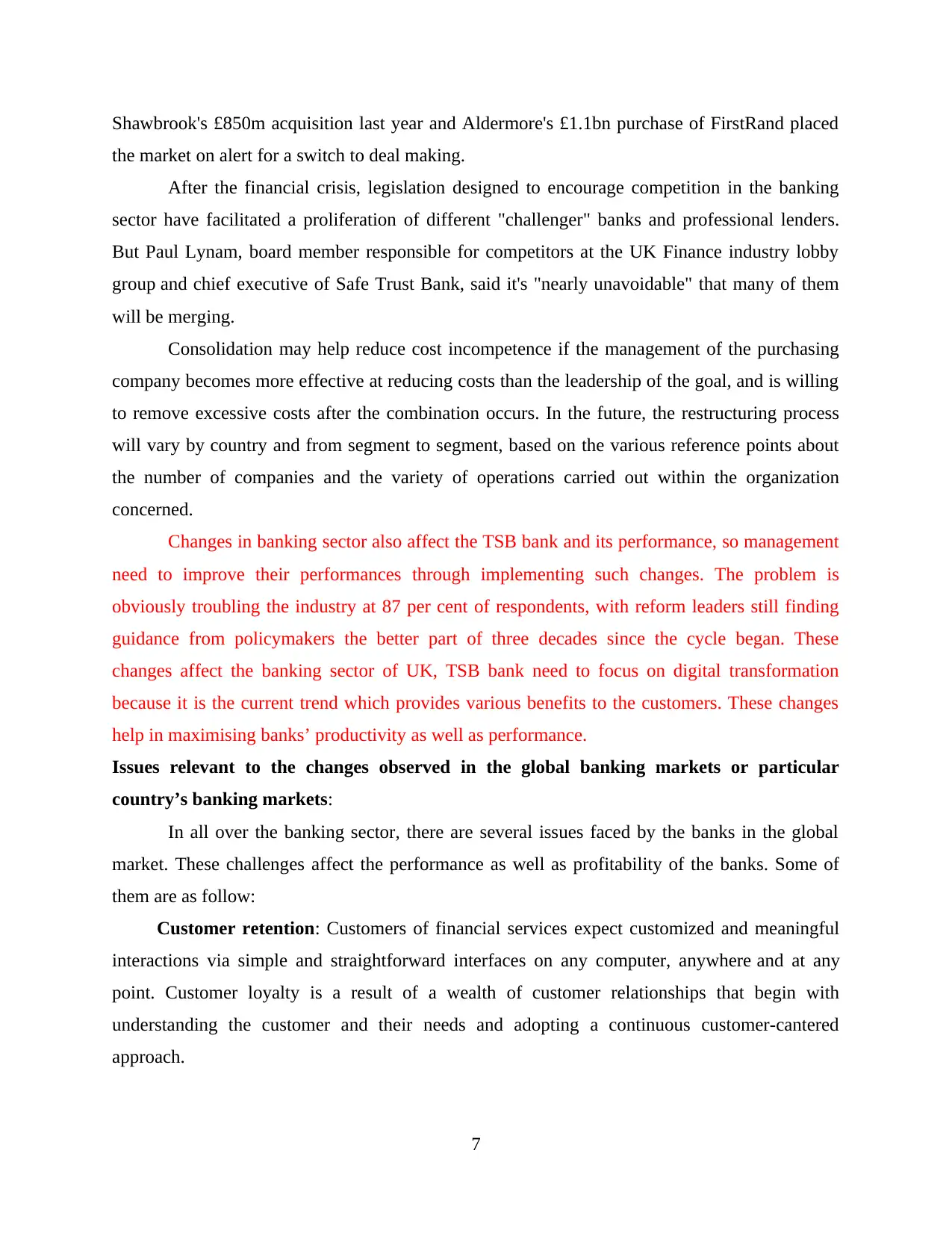
Shawbrook's £850m acquisition last year and Aldermore's £1.1bn purchase of FirstRand placed
the market on alert for a switch to deal making.
After the financial crisis, legislation designed to encourage competition in the banking
sector have facilitated a proliferation of different "challenger" banks and professional lenders.
But Paul Lynam, board member responsible for competitors at the UK Finance industry lobby
group and chief executive of Safe Trust Bank, said it's "nearly unavoidable" that many of them
will be merging.
Consolidation may help reduce cost incompetence if the management of the purchasing
company becomes more effective at reducing costs than the leadership of the goal, and is willing
to remove excessive costs after the combination occurs. In the future, the restructuring process
will vary by country and from segment to segment, based on the various reference points about
the number of companies and the variety of operations carried out within the organization
concerned.
Changes in banking sector also affect the TSB bank and its performance, so management
need to improve their performances through implementing such changes. The problem is
obviously troubling the industry at 87 per cent of respondents, with reform leaders still finding
guidance from policymakers the better part of three decades since the cycle began. These
changes affect the banking sector of UK, TSB bank need to focus on digital transformation
because it is the current trend which provides various benefits to the customers. These changes
help in maximising banks’ productivity as well as performance.
Issues relevant to the changes observed in the global banking markets or particular
country’s banking markets:
In all over the banking sector, there are several issues faced by the banks in the global
market. These challenges affect the performance as well as profitability of the banks. Some of
them are as follow:
Customer retention: Customers of financial services expect customized and meaningful
interactions via simple and straightforward interfaces on any computer, anywhere and at any
point. Customer loyalty is a result of a wealth of customer relationships that begin with
understanding the customer and their needs and adopting a continuous customer-cantered
approach.
7
the market on alert for a switch to deal making.
After the financial crisis, legislation designed to encourage competition in the banking
sector have facilitated a proliferation of different "challenger" banks and professional lenders.
But Paul Lynam, board member responsible for competitors at the UK Finance industry lobby
group and chief executive of Safe Trust Bank, said it's "nearly unavoidable" that many of them
will be merging.
Consolidation may help reduce cost incompetence if the management of the purchasing
company becomes more effective at reducing costs than the leadership of the goal, and is willing
to remove excessive costs after the combination occurs. In the future, the restructuring process
will vary by country and from segment to segment, based on the various reference points about
the number of companies and the variety of operations carried out within the organization
concerned.
Changes in banking sector also affect the TSB bank and its performance, so management
need to improve their performances through implementing such changes. The problem is
obviously troubling the industry at 87 per cent of respondents, with reform leaders still finding
guidance from policymakers the better part of three decades since the cycle began. These
changes affect the banking sector of UK, TSB bank need to focus on digital transformation
because it is the current trend which provides various benefits to the customers. These changes
help in maximising banks’ productivity as well as performance.
Issues relevant to the changes observed in the global banking markets or particular
country’s banking markets:
In all over the banking sector, there are several issues faced by the banks in the global
market. These challenges affect the performance as well as profitability of the banks. Some of
them are as follow:
Customer retention: Customers of financial services expect customized and meaningful
interactions via simple and straightforward interfaces on any computer, anywhere and at any
point. Customer loyalty is a result of a wealth of customer relationships that begin with
understanding the customer and their needs and adopting a continuous customer-cantered
approach.
7
Paraphrase This Document
Need a fresh take? Get an instant paraphrase of this document with our AI Paraphraser
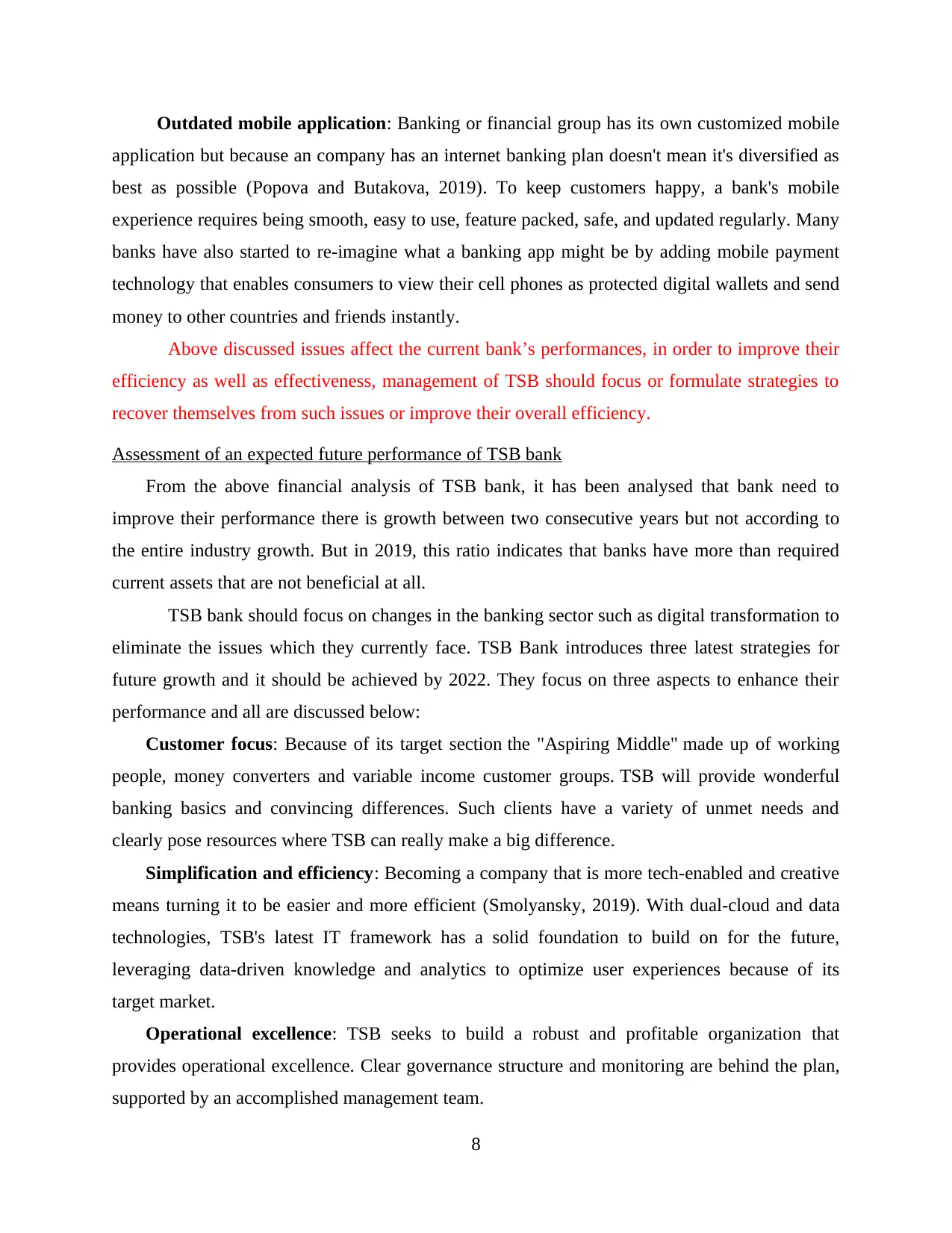
Outdated mobile application: Banking or financial group has its own customized mobile
application but because an company has an internet banking plan doesn't mean it's diversified as
best as possible (Popova and Butakova, 2019). To keep customers happy, a bank's mobile
experience requires being smooth, easy to use, feature packed, safe, and updated regularly. Many
banks have also started to re-imagine what a banking app might be by adding mobile payment
technology that enables consumers to view their cell phones as protected digital wallets and send
money to other countries and friends instantly.
Above discussed issues affect the current bank’s performances, in order to improve their
efficiency as well as effectiveness, management of TSB should focus or formulate strategies to
recover themselves from such issues or improve their overall efficiency.
Assessment of an expected future performance of TSB bank
From the above financial analysis of TSB bank, it has been analysed that bank need to
improve their performance there is growth between two consecutive years but not according to
the entire industry growth. But in 2019, this ratio indicates that banks have more than required
current assets that are not beneficial at all.
TSB bank should focus on changes in the banking sector such as digital transformation to
eliminate the issues which they currently face. TSB Bank introduces three latest strategies for
future growth and it should be achieved by 2022. They focus on three aspects to enhance their
performance and all are discussed below:
Customer focus: Because of its target section the "Aspiring Middle" made up of working
people, money converters and variable income customer groups. TSB will provide wonderful
banking basics and convincing differences. Such clients have a variety of unmet needs and
clearly pose resources where TSB can really make a big difference.
Simplification and efficiency: Becoming a company that is more tech-enabled and creative
means turning it to be easier and more efficient (Smolyansky, 2019). With dual-cloud and data
technologies, TSB's latest IT framework has a solid foundation to build on for the future,
leveraging data-driven knowledge and analytics to optimize user experiences because of its
target market.
Operational excellence: TSB seeks to build a robust and profitable organization that
provides operational excellence. Clear governance structure and monitoring are behind the plan,
supported by an accomplished management team.
8
application but because an company has an internet banking plan doesn't mean it's diversified as
best as possible (Popova and Butakova, 2019). To keep customers happy, a bank's mobile
experience requires being smooth, easy to use, feature packed, safe, and updated regularly. Many
banks have also started to re-imagine what a banking app might be by adding mobile payment
technology that enables consumers to view their cell phones as protected digital wallets and send
money to other countries and friends instantly.
Above discussed issues affect the current bank’s performances, in order to improve their
efficiency as well as effectiveness, management of TSB should focus or formulate strategies to
recover themselves from such issues or improve their overall efficiency.
Assessment of an expected future performance of TSB bank
From the above financial analysis of TSB bank, it has been analysed that bank need to
improve their performance there is growth between two consecutive years but not according to
the entire industry growth. But in 2019, this ratio indicates that banks have more than required
current assets that are not beneficial at all.
TSB bank should focus on changes in the banking sector such as digital transformation to
eliminate the issues which they currently face. TSB Bank introduces three latest strategies for
future growth and it should be achieved by 2022. They focus on three aspects to enhance their
performance and all are discussed below:
Customer focus: Because of its target section the "Aspiring Middle" made up of working
people, money converters and variable income customer groups. TSB will provide wonderful
banking basics and convincing differences. Such clients have a variety of unmet needs and
clearly pose resources where TSB can really make a big difference.
Simplification and efficiency: Becoming a company that is more tech-enabled and creative
means turning it to be easier and more efficient (Smolyansky, 2019). With dual-cloud and data
technologies, TSB's latest IT framework has a solid foundation to build on for the future,
leveraging data-driven knowledge and analytics to optimize user experiences because of its
target market.
Operational excellence: TSB seeks to build a robust and profitable organization that
provides operational excellence. Clear governance structure and monitoring are behind the plan,
supported by an accomplished management team.
8
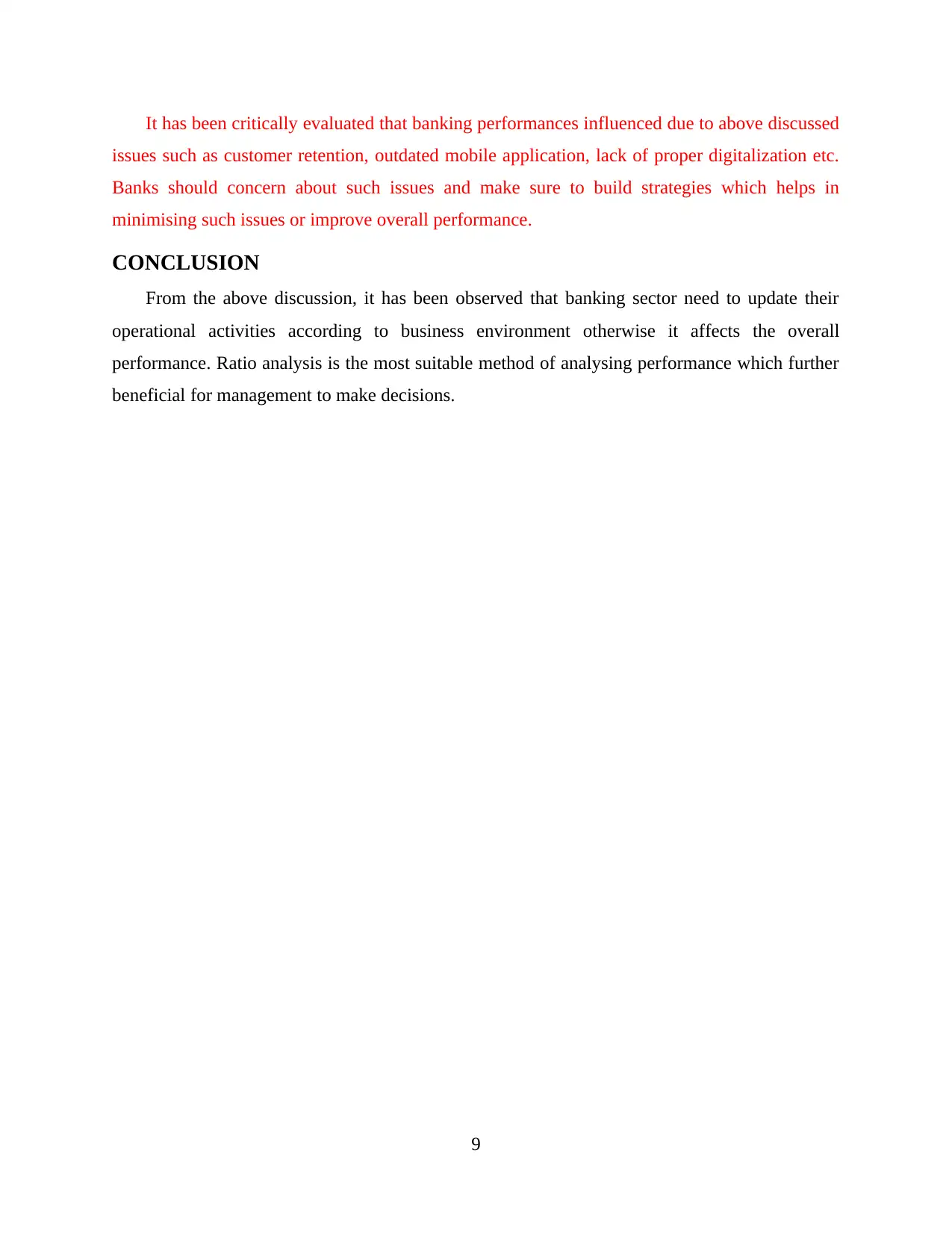
It has been critically evaluated that banking performances influenced due to above discussed
issues such as customer retention, outdated mobile application, lack of proper digitalization etc.
Banks should concern about such issues and make sure to build strategies which helps in
minimising such issues or improve overall performance.
CONCLUSION
From the above discussion, it has been observed that banking sector need to update their
operational activities according to business environment otherwise it affects the overall
performance. Ratio analysis is the most suitable method of analysing performance which further
beneficial for management to make decisions.
9
issues such as customer retention, outdated mobile application, lack of proper digitalization etc.
Banks should concern about such issues and make sure to build strategies which helps in
minimising such issues or improve overall performance.
CONCLUSION
From the above discussion, it has been observed that banking sector need to update their
operational activities according to business environment otherwise it affects the overall
performance. Ratio analysis is the most suitable method of analysing performance which further
beneficial for management to make decisions.
9
⊘ This is a preview!⊘
Do you want full access?
Subscribe today to unlock all pages.

Trusted by 1+ million students worldwide
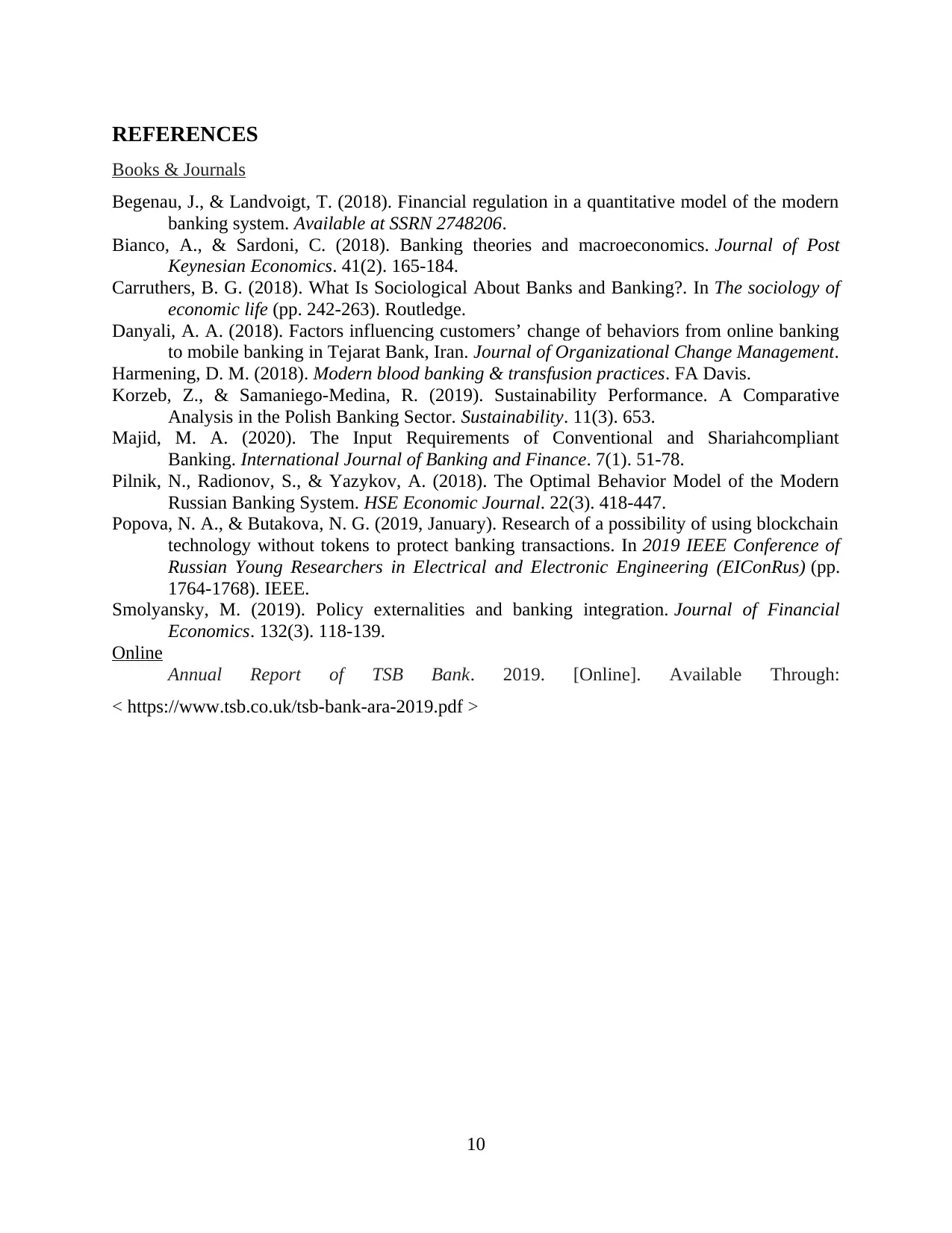
REFERENCES
Books & Journals
Begenau, J., & Landvoigt, T. (2018). Financial regulation in a quantitative model of the modern
banking system. Available at SSRN 2748206.
Bianco, A., & Sardoni, C. (2018). Banking theories and macroeconomics. Journal of Post
Keynesian Economics. 41(2). 165-184.
Carruthers, B. G. (2018). What Is Sociological About Banks and Banking?. In The sociology of
economic life (pp. 242-263). Routledge.
Danyali, A. A. (2018). Factors influencing customers’ change of behaviors from online banking
to mobile banking in Tejarat Bank, Iran. Journal of Organizational Change Management.
Harmening, D. M. (2018). Modern blood banking & transfusion practices. FA Davis.
Korzeb, Z., & Samaniego-Medina, R. (2019). Sustainability Performance. A Comparative
Analysis in the Polish Banking Sector. Sustainability. 11(3). 653.
Majid, M. A. (2020). The Input Requirements of Conventional and Shariahcompliant
Banking. International Journal of Banking and Finance. 7(1). 51-78.
Pilnik, N., Radionov, S., & Yazykov, A. (2018). The Optimal Behavior Model of the Modern
Russian Banking System. HSE Economic Journal. 22(3). 418-447.
Popova, N. A., & Butakova, N. G. (2019, January). Research of a possibility of using blockchain
technology without tokens to protect banking transactions. In 2019 IEEE Conference of
Russian Young Researchers in Electrical and Electronic Engineering (EIConRus) (pp.
1764-1768). IEEE.
Smolyansky, M. (2019). Policy externalities and banking integration. Journal of Financial
Economics. 132(3). 118-139.
Online
Annual Report of TSB Bank. 2019. [Online]. Available Through:
< https://www.tsb.co.uk/tsb-bank-ara-2019.pdf >
10
Books & Journals
Begenau, J., & Landvoigt, T. (2018). Financial regulation in a quantitative model of the modern
banking system. Available at SSRN 2748206.
Bianco, A., & Sardoni, C. (2018). Banking theories and macroeconomics. Journal of Post
Keynesian Economics. 41(2). 165-184.
Carruthers, B. G. (2018). What Is Sociological About Banks and Banking?. In The sociology of
economic life (pp. 242-263). Routledge.
Danyali, A. A. (2018). Factors influencing customers’ change of behaviors from online banking
to mobile banking in Tejarat Bank, Iran. Journal of Organizational Change Management.
Harmening, D. M. (2018). Modern blood banking & transfusion practices. FA Davis.
Korzeb, Z., & Samaniego-Medina, R. (2019). Sustainability Performance. A Comparative
Analysis in the Polish Banking Sector. Sustainability. 11(3). 653.
Majid, M. A. (2020). The Input Requirements of Conventional and Shariahcompliant
Banking. International Journal of Banking and Finance. 7(1). 51-78.
Pilnik, N., Radionov, S., & Yazykov, A. (2018). The Optimal Behavior Model of the Modern
Russian Banking System. HSE Economic Journal. 22(3). 418-447.
Popova, N. A., & Butakova, N. G. (2019, January). Research of a possibility of using blockchain
technology without tokens to protect banking transactions. In 2019 IEEE Conference of
Russian Young Researchers in Electrical and Electronic Engineering (EIConRus) (pp.
1764-1768). IEEE.
Smolyansky, M. (2019). Policy externalities and banking integration. Journal of Financial
Economics. 132(3). 118-139.
Online
Annual Report of TSB Bank. 2019. [Online]. Available Through:
< https://www.tsb.co.uk/tsb-bank-ara-2019.pdf >
10
1 out of 10
Related Documents
Your All-in-One AI-Powered Toolkit for Academic Success.
+13062052269
info@desklib.com
Available 24*7 on WhatsApp / Email
![[object Object]](/_next/static/media/star-bottom.7253800d.svg)
Unlock your academic potential
Copyright © 2020–2025 A2Z Services. All Rights Reserved. Developed and managed by ZUCOL.





